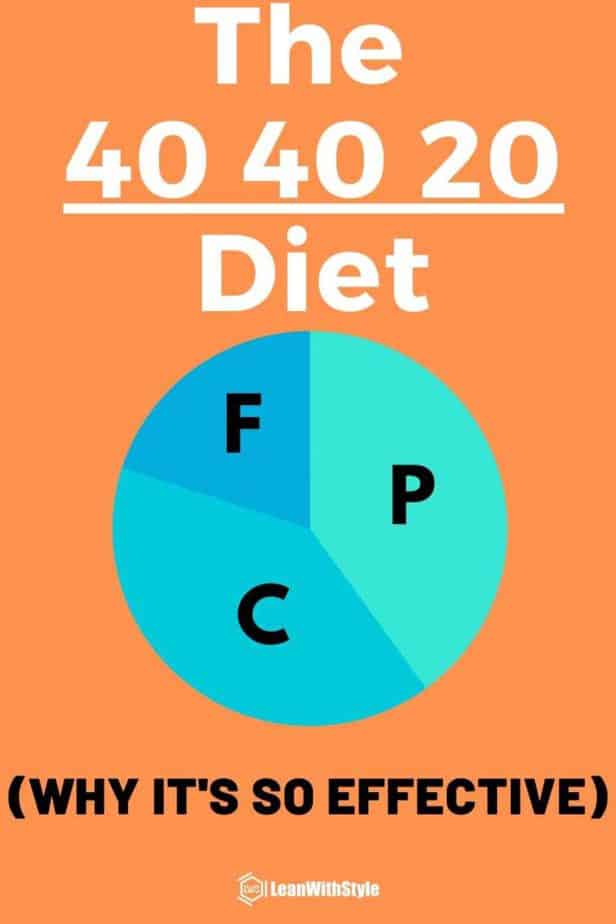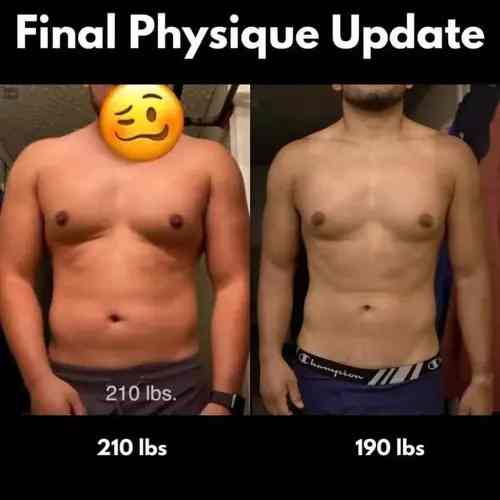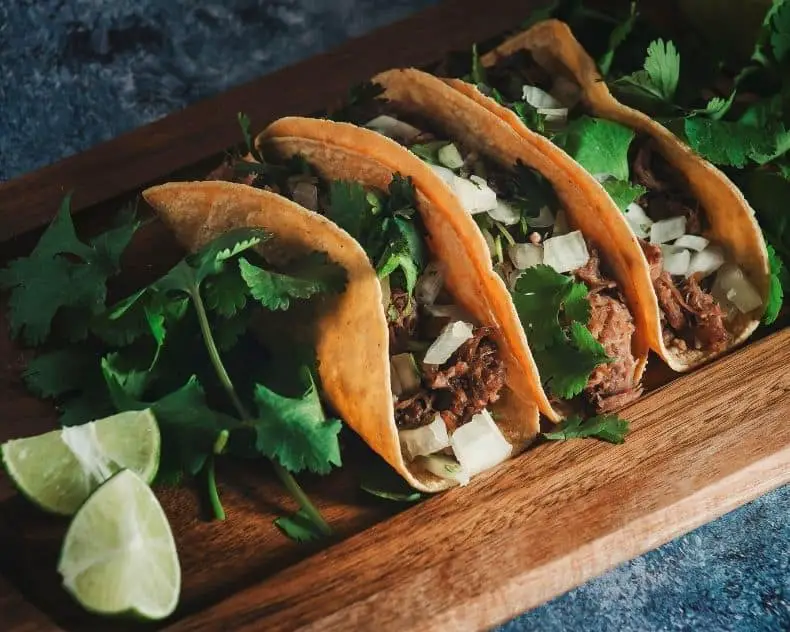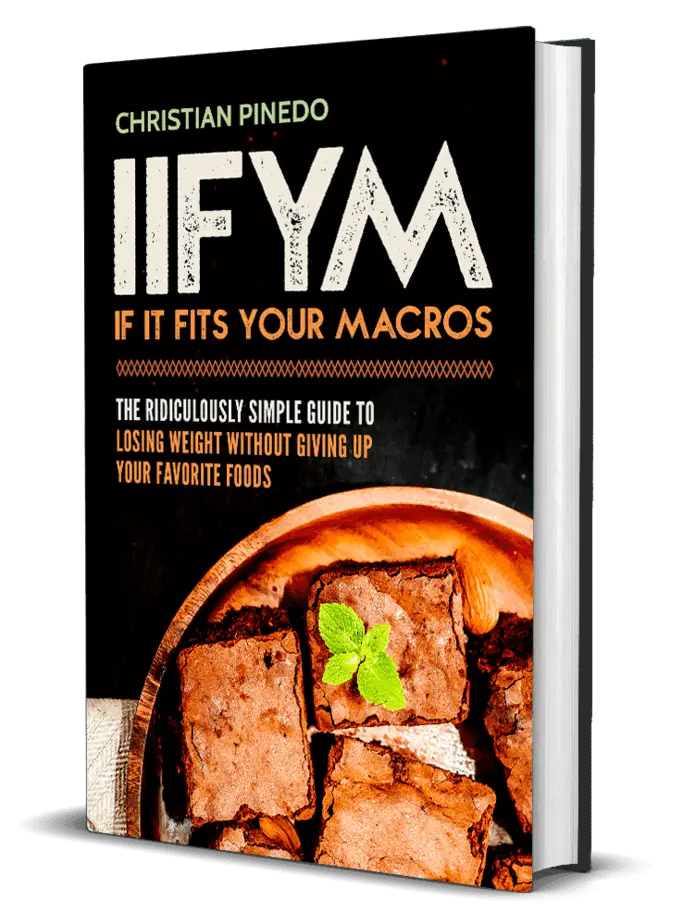In this article, we’re going over the 40 40 20 diet and why it’s so effective for weight loss.
If you’re not sure what it entails, it’s essentially where you take your calories, whether you want to lose weight, maintain your current weight, or lean bulk, and divide into 3 macronutrients.
The 3 “macros” being protein, fat, and carbs.
- 40 percent coming from protein.
- 40 percent coming from carbs.
- 20 percent coming from fats.
That’s the bare bones of this diet, but how do you follow it?
Let’s find out and go with a common example of someone who is about to start a fat loss phase.
We’ll call him Bob.
Let’s say Bob has to eat 2000 calories per day to lose weight.
Well, if we follow the 40 40 20 rule, it would look like this.
Note: There are 4 calories per gram of carbs and 4 calories per gram of protein. For fat, there are 9 calories per gram.


40 Percent Protein
To get 40 percent of our 2000 calories from protein, we need to multiple 2000 by .4.
2000 x .4 = 800
Because there are 4 calories per gram of protein, we need to divide 800 by 4 to get the amount of protein we need to eat per day, in grams.
800 / 4 = 200 g of protein to eat per day
40 Percent Carbohydrate
Because the percentages are the same for protein and carbohydrates, the calculation would be the same.
2000 x .4 = 800
800 / 4 = 200 g of carbs to eat per day.
20 Percent Fat
For fats, we only use 20 percent of our calories due to the number of calories per gram (9).
Therefore, the calculation would be:
2000 x .2 = 400
Again, because there are 9 calories per gram of fat, we would divide 400 by 9 (not 4 like we did for protein).
400 / 9 = 44 g of fat to eat per day.
Our final calories and macros for Bob would be:
- 2000 calories
- 200g of protein
- 200g of carbs
- 44g of fat
Bob would make sure to hit these calories and macros every day, but without going over them, to lose fat.
So now that we know how much Bob should be eating each and every day, how does Bob lose weight successfully?
How does Bob know where to start?
Well, that’s where tracking macros come into play.
What is Macro Dieting?
Macro dieting, IIFYM, flexible dieting, whatever you want to call it, they all require tracking macros that come from your meals.
When you create an IIFYM meal plan, your macros come from your weight and fitness goal, as we just calculated.
Note: You can use our free iifym calculator here.
Therefore, whenever you start a diet, you always want to know what your “numbers” are.
If you’re dieting, you want to know your diet macros.
The same goes for gaining or maintaining weight.
For Bob, he wanted to lose weight, and therefore, for his meal plan, he would end up eating the macros listed above and no more than that.
You would use an app called MyFitnessPal to track your food intake which tracks your macro and calorie intake at the same time.
You would need a food scale to measure out all your meals and it’s ingredients (brown rice, potatoes, chicken, etc.).
This is how you get successful with IIFYM and produce results.
If you’re not sure how to do this, check out this video:

This is how I ended up losing 50 lbs.!

Here are some other helpful videos for obtaining fat loss success:


So now that we know how to calculate our calories and macros following this rule, the question is why?
Why 40 40 20?
Is it magical?
Is it the best for fat loss?
Is a low fat diet really best for losing weight?
Let’s find out.
Why is the 40 40 20 Rule so effective?
One reason why this specific macro ratio for your diet is so effective is that you’re getting a great balance of Protein and Carbs.
Let’s talk about both really quick before going onto fat.
Protein
Protein is very filling and satiating which is very important when dieting.
If you have trouble with overeating all the time, you may need to experiment with a higher protein intake, which I’ve found to help with overeating.
I mean, have you ever tried to eat more than 12oz of chicken in one sitting? What about 12oz of steak or turkey for that matter?
It’s pretty hard, and if you cook it right, it can be delicious, filling and ultimately, satisfying, which, at the end of the day, is the most important factor.
I mean, think about it.
When anyone is trying to drop a few pounds, the hardest part is eating too much or learning to eat less.
It’s hard.
Eating more protein in your diet makes it harder to overeat and may lead to faster or better results.
Not only is getting a good amount of protein in your meals good for dieting, but it is also great for building and maintaining muscle while cutting or bulking.
If you get a sufficient amount, you will start to see better results than if you were to eat an inadequate amount of protein.
For example, let’s say you were following your diet and in a decent calorie deficit, but not getting enough protein.
In this example, you’d end up losing a ton of muscle and possibly obtaining the skinny fat physique.
I promise you that you do not want that physique. It’s not a good sight and if you do have it, make sure to read that article to figure out how to fix it.
In any case, get a good amount of protein in your diet.
If you’re doing it right, all your meals should contain protein in an ideal scenario. If you can make it fit that way, then you’re going to be on the right track.
Let’s switch over to carbs.
Carbs
Getting a good amount of carbs in your meals is a great way to stay energized and a better way to fuel your workouts.
Let’s face it, when you’re in a calorie deficit, you’re not eating as many calories as normal.
Therefore, your workouts suffer because of this and carbs are our energy source.
The more carbs we utilize, the better our performance will be in the gym simply by eating more carbs.
Most elite athletes utilize carbs and eat high carb diets.
No, 40 percent carbs aren’t too much for any diet.
In fact, in my experience, I’ve seen great benefit from going even higher than 40 percent when dieting, which we’ll go over soon.
Fat
Some of you may think that we’re going to low on fat, however, 20% is the lowest that I will ever recommend anyone to go to.
Fat is necessary for a multitude of functions in the body which I won’t go over right now.
Just know that you don’t ever want to go under 20% in your diet.
That’s the limit.
That being said, you could go higher, just make sure you’re getting enough protein (at least 0.8-1.2g of protein per pound of body weight).
My Experience with the 40 40 20 Rule
I follow this diet rule every time I try to cut weight.
My calories may fluctuate but my macro ratio stays the same. I think that it’s the best macro ratio for cutting.
In terms of my training, I don’t see many drawbacks.
I follow a strength training routine and this macro ratio allows me to push myself in the gym without ever feeling like I need more carbs or protein in my diet.
Alternative Macro Ratios That Are Great
If you prefer more fat in your diet, I’ve seen people obtain great success with the following macro ratios (P% / C% / F%):
- 35/35/30
- 30/50/20
- 37.5/37.5/25
Essentially, just play around with the numbers and you should be fine.
Just remember that you need to be getting a sufficient amount of protein or your diet and physique will suffer for it.
The gold standard is to get at least 0.8 grams of protein per pound of body weight.
For most people and simplicity, they go with 1 gram of protein per pound of body weight.
Regardless, as long as you are in a calorie deficit, sticking to your meal plan, tracking your macros for all your meals, you should see great results!
100% Complete Diet Solution
If you’re looking for a complete solution for losing weight while tracking macros, then you want to check out my book on IIFYM.
Learning how to lose weight without giving up your favorite foods is hard to learn if you don’t start right.
My book teaches you exactly how to get started.
It’s loaded with free bonuses, materials, spreadsheets, and comes with a companion course.





hello i am 5’7 150 pounds at 17 and am very active. I am clean bulking using the 40, 40, 20 i am in a calorie surplus of 2,900 should i lower my calories or keep them the same?
Hey Wesly, it all depends on how your weight/body responds to the surplus. Is your weight going up on average every week? What about your waistline? These are two things you want to track when bulking and cutting. If you’re gaining weight to fast, lower them and if not, keep them the same until it no longer produces weight gain. Hope this helps!
I’m just starting the 40,40,20 but only want to have my total kcals to be 1500 not 2000, therefore how much kcal’s should be protein, carbs and fats.
Thanks
Hi Ceri!
There are 4 cal/g of protein, 4 cal/g of carb, and 9 cal/g of fat.
If we do the math, we get the following:
1500 x 40% protein = 600 calories from protein.
Since there are 4 cal/g of protein, we just divide 600 by 4:
600 / 4 = 150g of protein.
For carbs, since we’re using the same 40%, we get the same result.
150g of Carbs.
Now for fat, we just do 20% and divide by 9 instead of 4:
1500 x 20% = 300 calories from fat
300 / 9 = 33g of fat.
So, for a 40/40/20 split for 1500 calories, we get:
150g protein
150g carbs
33g fat
Hope this helps!
This was very helpful.
Thanks a lot!!
You’re very welcome! Glad it helped.
Excellent site. Clear explanations — as the math teacher used to say, “Show your work!”… and you do. Appreciated. Here’s my question:
At ~300lbs (gained a lot of weight during the past year — “Ate more, moved less”… a lot less). So, it’s weight-loss time. I’ve settled on 1,200kcal/day, which translates to 120/120/26 (C/P/F, using your 40:40:20 ratio). OK, I’d like to combine it with Intermittent Fasting, using 12:12 (8PM to 8AM fasting, then a cuppa coffee, light/sweet, then a rowing workout, then eating 12PM to 8PM).
What do you think? I know the morning coffee will “break” the fast, but I’m soon to turn 70, and it’s “DNA-deep”. The rowing is long-and-slow (10K), with the occasional high-intensity intervals thrown in.
I’m 6’1″, and my goal is sub-200lbs.
PS: I don’t have upper teeth (lol, long story), so I eat a lot of steamed vegetables, plus whey protein powder and canned tuna/mackeral/salmon. No problem with the 120C/120P. The issue is fats: I love my Half ‘n Half.
Hey Jonathan, I responded to your other comment. Let me know if you have any questions. Glad to help!
Hi!
Never mind my comment — I hadn’t seen the IF article on LeanStyle. Anyway, I’ve been doing that for years, 16:8, but this last year I didn’t control my eating — not calories, not macros — I chart my food, but ate way too much, lol.
So, please disregard my comment. I’ll keep reading… and implementing 40:40:20. Thanks!
Glad I could help Jonathan! Let me know if you have any questions. Glad to help!
Hey great content. Started a year ago in keto dropped 65 lbs changed my diet to 40/40/20 found out I’m gluten intolerant. I hit the gym 3-5 days a week running 2500 calories a day very active large frame dude 6ft 1 current weight 235. I lift heavy and work hard cut trees for a living . I have about 40 lbs to go in my mind but I’m flat staying at this weight not up not down waist isn’t growing . Do I drop calories? Or hold and see what it’s like in 6 months . Any help is appreciated thanks!
Hi Bill, Sorry for the late reply. It seems to me that you’ve found your “maintenance” calorie intake. If you want to continue losing weight, drop your calories by 100 and start there. You could also just add extra cardio if you have a good eating routine right now.
Hello, I have doubts about the 4g calories, how did you arrive at this count?
Hi Camila, are you talking about the 4 calories per gram?